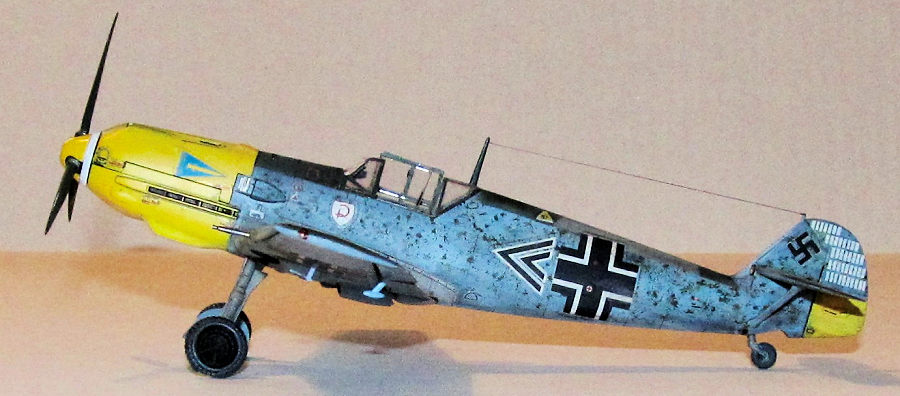
| KIT #: | J2 |
| PRICE: | $30.00 |
| DECALS: | Four options |
| REVIEWER: | Dan Lee |
| NOTES: | Ultracast seat and Master barrels |

| HISTORY |
The Bf-109 Emil needs no introduction to modellers.
Helmut Paul Emil Wick was born on 5 August 1915 in Mannheim, Germany, the youngest of three children of a civil engineer, Karl Wick and Berta Wick, née Schenck. Helmut's eldest brother Walter was born in Swakopmund, at the time in the German protectorate in South-West Africa. After the outbreak of World War I, the family returned to Germany. Owing to the demand for his father's skills and expertise building roads and bridges, Helmut spent most of his childhood traveling throughout the German Empire. The Wick family moved to Hanover in 1919; Helmut's mother died there in February 1922. His father then took the family to Oliva, near Danzig and Königsberg in East Prussia, finally settling in Berlin in 1935.
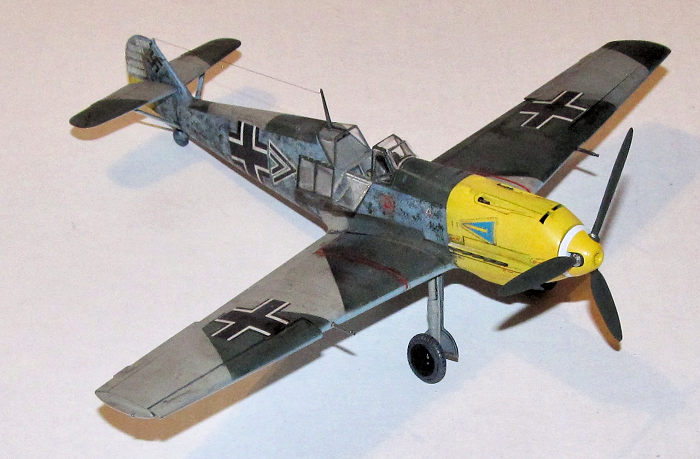 Upon
graduating from Gymnasium (secondary school) in 1935, Wick applied to the
officer candidate course of the new German Air Force. Scoring well on the
suitability tests, he was accepted into the German military on 6 April 1936 at
the Luftwaffe officer candidate school in Dresden, after completing compulsory
Reich Labour Service. He swore the oath of allegiance to Adolf Hitler on 16
April. After passing officer training courses, Wick was assessed as "well suited
to become an officer" on 13 July. He then started flight training and shortly
later soloed in a Focke-Wulf Fw 44 "Stieglitz". Wick was considered an average
pilot and had difficulties with his theoretical training, especially those
topics that were of little or no interest to him. In early May 1937, he was
briefly transferred to the 6. Staffel (6th squadron) of Kampfgeschwader 254
(254th Bomber Wing). A month later he returned to Dresden to complete his
officer training.
Upon
graduating from Gymnasium (secondary school) in 1935, Wick applied to the
officer candidate course of the new German Air Force. Scoring well on the
suitability tests, he was accepted into the German military on 6 April 1936 at
the Luftwaffe officer candidate school in Dresden, after completing compulsory
Reich Labour Service. He swore the oath of allegiance to Adolf Hitler on 16
April. After passing officer training courses, Wick was assessed as "well suited
to become an officer" on 13 July. He then started flight training and shortly
later soloed in a Focke-Wulf Fw 44 "Stieglitz". Wick was considered an average
pilot and had difficulties with his theoretical training, especially those
topics that were of little or no interest to him. In early May 1937, he was
briefly transferred to the 6. Staffel (6th squadron) of Kampfgeschwader 254
(254th Bomber Wing). A month later he returned to Dresden to complete his
officer training.
Wick failed to pass the third course of his training but was given a second chance and on 1 April 1938 reported to the officer candidate school at the Luftkriegsschule 3 (LKS 3—3rd air war school), Wildpark-West near Werder. He successfully completed the course and in mid-1938 started special pilot training at the Fighter Training facility at Werneuchen. Upon graduation, he was assigned to II.Gruppe Jagdgeschwader 135 (135th Fighter Wing) which on 1 November 1938 became Jagdgeschwader 333 (333rd Fighter Wing) under Oberstleutnant (Lieutenant Colonel) Max Ibel at Herzogenaurach, flying obsolete Arado Ar 68 biplane fighters. On 8 November 1938, Oberfähnrich (senior ensign) Wick was promoted to Leutnant (second lieutenant) and on 1 January 1939 was transferred to 1. Staffel of Jagdgeschwader 133 (133rd Fighter Wing), which was later renamed Jagdgeschwader 53 (JG 53—53rd Fighter Wing). It was there that Wick began flying the Messerschmitt Bf 109 monoplane fighter under the tutelage of Werner Mölders, a Spanish Civil War flying ace credited with 14 aerial victories. Under Mölders' guidance, Wick became a Schwarmführer (flight leader).
Phoney War and Battle of France
On 31 August 1939 Wick was given orders to transfer to "Jagdgeschwader
Richthofen Nr. I". At the time there was no such unit; the intention was to send
him to Jagdgeschwader 1 (JG 1−1st Fighter Wing), based in Döberitz, near Berlin.
During World War I the "Richthofen Geschwader" name had been attached to the
World War I era Jagdgeschwader 1. The "Richthofen" name had been incorrectly put
on Wick's order. Wick noticed the mistake, realizing that he could now choose
between JG 1 or the famous Jagdgeschwader 2 (JG 2—2nd Fighter Wing) which
currently bore the "Richthofen" name. He chose the Richthofen Geschwader,
commanded by Oberst (Colonel) Gerd von Massow, the unit was equipped with the Bf
109 E-3 and used the tactical code Yellow 3. On 1 September, Wick joined its 3.
Staffel, serving in the air defence of Berlin during the Polish Campaign. Fol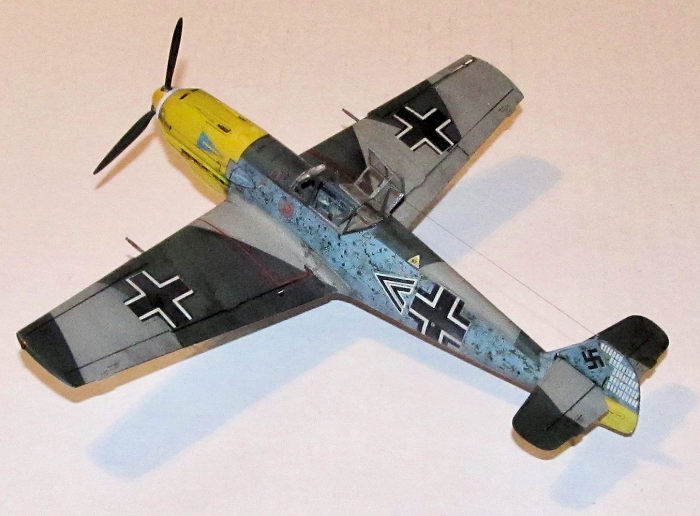 lowing
the German victory in Poland, JG 2 was transferred to Frankfurt-Rebstock and
tasked with protection of Germany's Western border during the Phoney War—the
phase between Britain and France's declaration of war on Germany in September
1939, and the Battle of France in May 1940. Flying his sixth combat mission,
Leutnant Wick claimed his first, and the Geschwader's second victory on 22
November 1939. For this feat, Wick received the Iron Cross 2nd Class (Eisernes
Kreuz 2. Klasse).
lowing
the German victory in Poland, JG 2 was transferred to Frankfurt-Rebstock and
tasked with protection of Germany's Western border during the Phoney War—the
phase between Britain and France's declaration of war on Germany in September
1939, and the Battle of France in May 1940. Flying his sixth combat mission,
Leutnant Wick claimed his first, and the Geschwader's second victory on 22
November 1939. For this feat, Wick received the Iron Cross 2nd Class (Eisernes
Kreuz 2. Klasse).
On 10 May 1940, German forces launched an offensive in Western Europe, but Wick remained on the ground while his aircraft, Bf 109 Yellow 2, underwent an engine change. Seven days later, he was back in the air, recording three victories over French LeO 45 bombers in one mission. By 6 June, Wick had 10 confirmed and two unconfirmed victories, including four French Bloch 151/152 fighters that he shot down on 5 June to record his fourth through seventh victories. The two unconfirmed victories were Royal Navy Fairey Swordfish biplane torpedo bombers claimed on 19 May and for which he had no witnesses.
The next day Wick became the first pilot of the I. Gruppe to complete 100 combat missions, claiming his eighth and ninth victory the same day. For this achievement he was awarded the Iron Cross 1st Class (Eisernes Kreuz 1. Klasse).
Battle of Britain
During the Battle of Britain against the Royal Air Force (RAF) in mid-1940, Wick rose quickly in rank and in profile, both in the battle zone and as a propaganda hero back in Germany where the authorities began an unsurpassed media campaign on his behalf.
On 21 July 1940, the just promoted Oberleutnant (first lieutenant) also became leader of 3. Staffel, succeeding Major Henning Stümpell. Wick recorded his 20th victory on 25 August and added two more fighters a day later. In so doing, JG 2 surpassed the 250-mark. Achieving 20 aerial victories made Wick eligible for the Knight's Cross of the Iron Cross (Ritterkreuz des Eisernen Kreuzes), a higher grade of the Iron Cross. Wick was awarded the Knight's Cross of the Iron Cross on 27 August 1940 at Karinhall by Hermann Göring.
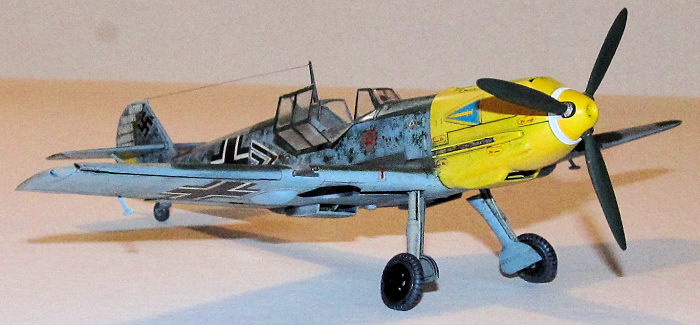 Upon his
return to France, Wick was promoted to Hauptmann and on 9 September was named
Gruppenkommandeur (group commander) of I. Gruppe of JG 2. On 5 October gained
his 41st combat victory on his way to overtake his two closest rivals, Major
Adolf Galland and Oberstleutnant Mölders. The 41st victory earned him his second
reference in the Wehrmachtbericht on 6 October 1940. He also became the fourth
member of the armed forces to receive the Knight's Cross of the Iron Cross with
Oak Leaves (Ritterkreuz des Eisernen Kreuzes mit Eichenlaub).
Upon his
return to France, Wick was promoted to Hauptmann and on 9 September was named
Gruppenkommandeur (group commander) of I. Gruppe of JG 2. On 5 October gained
his 41st combat victory on his way to overtake his two closest rivals, Major
Adolf Galland and Oberstleutnant Mölders. The 41st victory earned him his second
reference in the Wehrmachtbericht on 6 October 1940. He also became the fourth
member of the armed forces to receive the Knight's Cross of the Iron Cross with
Oak Leaves (Ritterkreuz des Eisernen Kreuzes mit Eichenlaub).
Wick received orders in the late afternoon of 6 October to report to Reichsmarschall Göring in Berlin by 3 p.m. the following day. Wick was then exposed by Otto Dietrich, the Third Reich's Press Chief, to the international public at a press conference and presented as a "hero". His performance left a predominantly negative impression, since Wick presented himself as a "busybody" (Life Magazine), and made fun of his victims.
On 19 October 1940, Wick was promoted to Major and appointed Geschwaderkommodore (wing commander) of JG 27. He had no ambition to leave his Gruppe in JG 2 "Richthofen" and, after giving the matter some thought, asked Göring to let him remain with his Gruppe instead. The next day Göring revoked his decision and gave Wick command of JG 2 "Richthofen" at 25 years of age, he thus became the youngest Major and Geschwaderkommodore in the Luftwaffe.
In November 1940 Wick continued to claim steadily. On 5 November he filed claims for another three RAF fighters northeast of Portland. Fighter Command suffered no losses in the region. On 6 November, JG 2 used Junkers Ju 87 Stukas as bait to lure the RAF into combat. The ploy succeeded and Wick claimed five aerial victories again. Wick's airmen claimed eight in total; five are confirmed by Fighter Command confirming the claims as reasonably accurate.
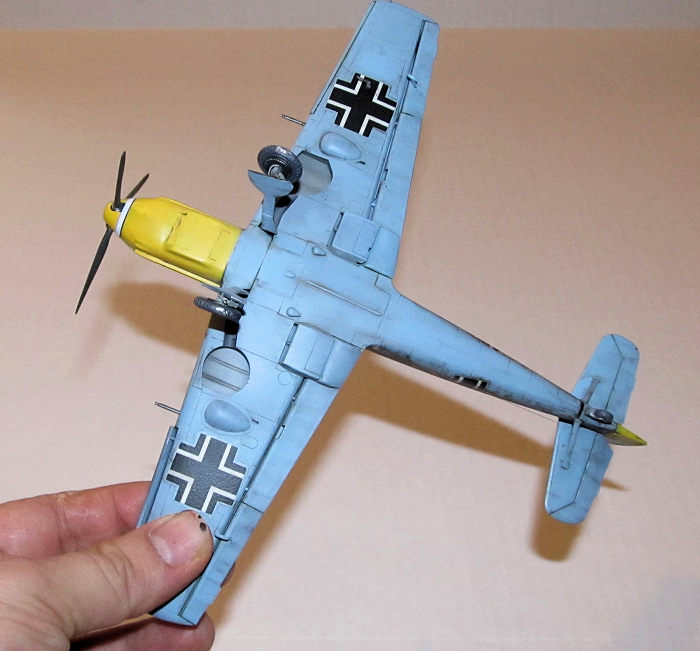 Helmut
Wick claimed his 55th aerial victory when he shot down a Spitfire on the
afternoon of 28 November 1940. This made Wick the highest-scoring fighter pilot
in the Luftwaffe, surpassing Mölders, whose score at the time stood at 54
victories. It was a position which Wick would enjoy for only two hours.
Returning from this mission to Cherbourg- Querqueville, Wick ordered the
aircraft refueled and re-armed. Together with his wingman, Wick took off at 4:10
p.m. and returned to the vicinity of the Isle of Wight. Spotting a flight of
Spitfires he climbed to intercept from a more favourable attack position. In a
diving attack Wick shot down and killed Pilot Officer Paul A. Baillon, of No.
609 Squadron, flying Spitfire R6631.
Helmut
Wick claimed his 55th aerial victory when he shot down a Spitfire on the
afternoon of 28 November 1940. This made Wick the highest-scoring fighter pilot
in the Luftwaffe, surpassing Mölders, whose score at the time stood at 54
victories. It was a position which Wick would enjoy for only two hours.
Returning from this mission to Cherbourg- Querqueville, Wick ordered the
aircraft refueled and re-armed. Together with his wingman, Wick took off at 4:10
p.m. and returned to the vicinity of the Isle of Wight. Spotting a flight of
Spitfires he climbed to intercept from a more favourable attack position. In a
diving attack Wick shot down and killed Pilot Officer Paul A. Baillon, of No.
609 Squadron, flying Spitfire R6631.
Shortly afterwards, around 5 p.m., Wick's Bf 109 E-4 (Werknummer 5344 — factory number) was shot down, probably by twelve–victory ace Flight Lieutenant John Dundas of No. 609 Squadron. Rudolf Pflanz saw a Spitfire shoot down a Bf 109, whose pilot bailed out. Pflanz then shot down the Spitfire, which he observed to crash in the sea with its pilot still inside.
Only later did Pflanz find out that it was Wick he saw bailing out. Göring had ordered Kriegsmarine torpedo boats on a night-long search-and-rescue mission for Wick. The next day, other naval vessels and the Seenotdienst (air-sea rescue) service, escorted by fighters of JG 2, continued in vain to search for him. It has been claimed the Germans used international airwaves to contact the RAF Air Ministry for information on Wick's fate. He was never found, however, and the Luftwaffe declared him missing in action, presumed dead, on 4 December 1940, in the daily Wehrmachtbericht. The loss of the irreplaceable Wick had a detrimental effect on morale in JG 2.
| THE KIT |
See Scott's review of the Haseagawa J3 boxing. The only difference I noticed between the J2 and J3 is the decals and lacking the desert filter parts.
| CONSTRUCTION |
The Hasegawa Bf109E-4 is a fairly simple kit to build. Construction began with spraying the cockpit parts RLM02 and/or RLM66. The finer details were painted with red, white, silver and blue. I didn't add the missing fuel lines because the cockpit was cramped enough as it was. I did drill out the holes for the rudder pedals with a number 70 bit.
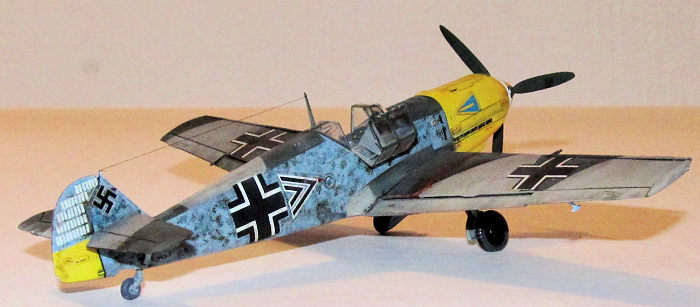 With the
cockpit completed and painted, it was installed into the fuselage. One of the
easy things about most Bf109 models is that you don't need to do much seam
filling/sanding work thanks the real life seam running down most of the rear
fuselage. I only needed to use CA glue along the top deck of the fuselage before
the windscreen, tail and along the wing tips. A bit of 400 and 600 wet/dry
sandpaper took care of those seams.
With the
cockpit completed and painted, it was installed into the fuselage. One of the
easy things about most Bf109 models is that you don't need to do much seam
filling/sanding work thanks the real life seam running down most of the rear
fuselage. I only needed to use CA glue along the top deck of the fuselage before
the windscreen, tail and along the wing tips. A bit of 400 and 600 wet/dry
sandpaper took care of those seams.
I removed the plastic solid guns and left them open for pre painted Master brass gun barrels post painting. At this point, the wing wells, landing gear, prop, prop hub and others parts were painted and weathered before main painting.
| COLORS & MARKINGS |
I opted to do Helmut Wick's Oct 1940 markings. I had intended to build this model with Wick's unique camo, but for a long time I was clueless as to how to recreate the markings till I watched a youtube video on using sponges to weather armor a month before I built this model (summer of 2019.) A lightbulb came on.
First the model was primed with Stynylrez primer. After it was dry, the model was painted using the basic RLM70/71/65 color scheme with hard masks made from low tack 3M painters tape. I used Xtracrylix for all of the colors as my beloved Gunze paint had dried up or run out.
After the paint was dry, I dipped torn sponges in RLM71 or
RLM70 paint using tweezers, removed as much paint as I could with a paper towel
and then dabbed the sponge on the surface in random patterns. It might not be
exact, b ut
it was the look I wanted so the entire rear fuselage was painted.
ut
it was the look I wanted so the entire rear fuselage was painted.
Meanwhile the nose was masked off and painted flat white then RLM04 Gelb.
I used the kit decals for Wick's plane. Outside of the well known problem of ivory for white and despite the age of the decals, they held up well and did not cause any problems. MicroSol/Set was used with a dab of Solvaset for the stubborn ones.
As for weathering, I used a mix of black/burnt umber oil paints thinned with turpenoid (and open windows) to give the plane a slightly used look and to bring out the fine details. Once everything was dry, I sprayed on Tamiya flat clear for the final coat.
The pre painted brass guns were added to the wings and fuselage held in with tiny dabs of CA glue. Next the canopy was installed with the kit supplied Photo Etch headrest which was held in with Elmer's white glue (both canopy and PE parts.
Lastly, the prepainted Ultracast resin seat, kit gunsight, landing gear and antenna were added on. I used Uni flyfishing line and tiny amounts of CA glue for the wire antenna. The prop was left to freely rotate.
| CONCLUSIONS |
Despite its age and flaws (nose contour and too skinny fuselage), the original Hasegawa Bf109-E4 is a nice simple kit to build for any skill level. Plenty of aftermarket options including many for those who don't want to build a swastika bedecked aircraft.
16 July 2020
Copyright ModelingMadness.com
If you would like your product reviewed fairly and fairly quickly, please contact the editor or see other details in the Note to Contributors.
Back to the Main Page Back to the Review Index Page Back to the Previews Index Page